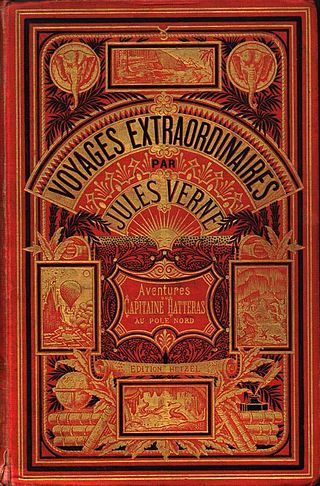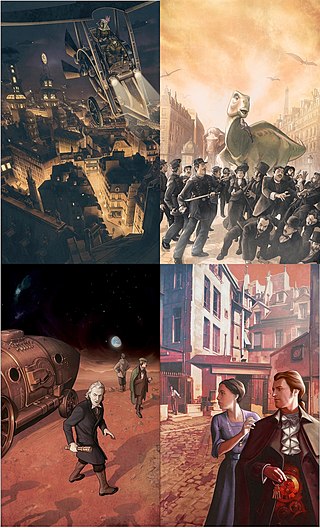Events
| | This section is empty. You can help by adding to it. (February 2016) |
| Years in science fiction |
|---|
| History of science fiction Timeline of science fiction |
The year 1910 was marked, in science fiction, by the following events.
| | This section is empty. You can help by adding to it. (February 2016) |
The main science-fiction Awards known at the present time did not exist at this time.
=== Movies ===
A Trip To Mars (1910) This film sees a scientist visit Mars though the use of an unnamed compound of dust like composition.

Fritz Reuter Leiber Jr. was an American writer of fantasy, horror, and science fiction. With writers such as Robert E. Howard and Michael Moorcock, Leiber is one of the fathers of sword and sorcery.

Jules Gabriel Verne was a French novelist, poet and playwright.

Twenty Thousand Leagues Under the Seas is a science fiction adventure novel by the French writer Jules Verne. It is often considered a classic within both its genres and world literature. The novel was originally serialised from March 1869 to June 1870 in Pierre-Jules Hetzel's French fortnightly periodical, the Magasin d'éducation et de récréation. A deluxe octavo edition, published by Hetzel in November 1871, included 111 illustrations by Alphonse de Neuville and Édouard Riou.

Scientific romance is an archaic, mainly British term for the genre of fiction now commonly known as science fiction. The term originated in the 1850s to describe both fiction and elements of scientific writing, but it has since come to refer to the science fiction of the late nineteenth and early twentieth centuries, primarily that of Jules Verne, H. G. Wells and Arthur Conan Doyle. In recent years the term has come to be applied to science fiction written in a deliberately anachronistic style as a homage to or pastiche of the original scientific romances.

The Voyages extraordinaires is a collection or sequence of novels and short stories by the French writer Jules Verne.

Jean François Paschal Grousset was a French politician, journalist, translator and science fiction writer. Grousset published under the pseudonyms of André Laurie, Philippe Daryl, Tiburce Moray and Léopold Virey.

Louis Henri Boussenard was a French author of adventure novels, dubbed "the French Rider Haggard" during his lifetime, but known better presently in Eastern Europe than in Francophone countries. As a measure of his popularity, 40 volumes of his collected works were published in Imperial Russia during 1911.

Dr. Ox's Experiment is a humorous science fiction novella by the French writer Jules Verne, published in 1872. It describes an experiment by one Dr. Ox, and is inspired by the real or alleged effects of oxygen on living things.

Gustave Henri Joseph Le Rouge was a French writer who embodied the evolution of modern science fiction at the beginning of the 20th century, by moving it away from the juvenile adventures of Jules Verne and incorporating real people into his stories, thus bridging the gap between Vernian and Wellsian science fiction.

"A Drama in the Air" is an adventure short story by Jules Verne. The story was first published in August 1851 under the title "Science for families. A Voyage in a Balloon" in Musée des familles with five illustrations by Alexandre de Bar. In 1874, with six illustrations by Émile-Antoine Bayard, it was included in Doctor Ox, the only collection of Jules Verne's short stories published during Verne's lifetime. An English translation by Anne T. Wilbur, published in May 1852 in Sartain's Union Magazine of Literature, marked the first time a work by Jules Verne was translated into the English language.

The Secret of Wilhelm Storitz is a fantasy novel by Jules Verne, published by Louis-Jules Hetzel in 1910. The manuscript was written around 1897. It was the last one Verne sent to Hetzel.
French science fiction is a substantial genre of French literature. It remains an active and productive genre which has evolved in conjunction with anglophone science fiction and other French and international literature.

Journey Through the Impossible is an 1882 fantasy play written by Jules Verne, with the collaboration of Adolphe d'Ennery. A stage spectacular in the féerie tradition, the play follows the adventures of a young man who, with the help of a magic potion and a varied assortment of friends and advisers, makes impossible voyages to the center of the Earth, the bottom of the sea, and a distant planet. The play is deeply influenced by Verne's own Voyages Extraordinaires series and includes characters and themes from some of his most famous novels, including Twenty Thousand Leagues Under the Seas, Journey to the Center of the Earth, and From the Earth to the Moon.

Jules Verne (1828–1905) was a French novelist, poet, and playwright. Most famous for his novel sequence, the Voyages Extraordinaires, Verne also wrote assorted short stories, plays, miscellaneous novels, essays, and poetry. His works are notable for their profound influence on science fiction and on surrealism, their innovative use of modernist literary techniques such as self-reflexivity, and their complex combination of positivist and romantic ideologies.

In the Year 2889 is an 1889 short story published under the name of Jules Verne, but now believed to be mainly the work of his son Michel Verne, based on his father's ideas. The first publication was in English in February 1889, in the American magazine The Forum.

Michèle Laframboise is a Canadian science fiction writer and comics artist.

Jules Verne (1828–1905), the French writer best known for his Voyages extraordinaires series, has had a wide influence in both scientific and literary fields.
The year 1889 was marked, in science fiction, by the following events.

Merveilleux scientifique is a literary genre that developed in France from the end of the 19th century to the middle of the 20th century. Akin today to science fiction, this literature of scientific imagination revolves around key themes such as mad scientists and their extraordinary inventions, lost worlds, exploration of the solar system, catastrophes and the advent of supermen.

Le Rayon fantastique was a collection of science fiction novels co-published by éditions Gallimard and Hachette between January 1951 and February 1964. The first work in the collection was Assassinat des États-Unis de Will Jenkins.